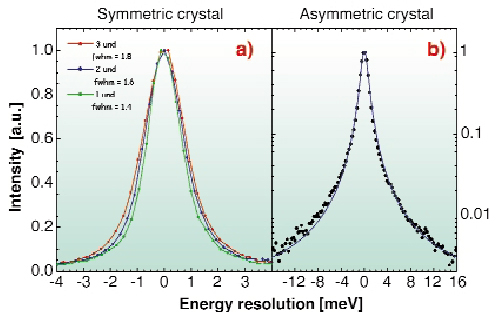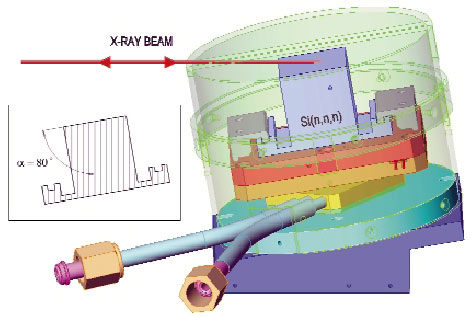- Home
- Users & Science
- Scientific Documentation
- ESRF Highlights
- ESRF Highlights 2003
- Method and Instrumentation
- Development of an Asymmetrically-cut Backscattering Monochromator for Very High Energy Resolution Inelastic X-ray Scattering
Development of an Asymmetrically-cut Backscattering Monochromator for Very High Energy Resolution Inelastic X-ray Scattering
Inelastic X-ray scattering (IXS) with meV energy resolution has become a routine tool for the study of phonon dispersions, and is applied to a large class of different materials. At the ESRF beamlines ID16 and ID28 are fully dedicated to this technique. One of the key components is the very high-energy resolution monochromator, which is located downstream of the cryogenically-cooled silicon (1 1 1) premonochromator. It utilises a high-order Bragg reflection from a perfect silicon crystal close to backscattering geometry in order to achieve an energy resolution in the meV range and to match the vertical X-ray beam divergence. In contrast to conventional monochromators, where the energy is scanned by changing the incidence angle, in the present case the monochromator temperature is varied [1,2]. As a matter of fact: ![]() E/E =
E/E = ![]() d/d =
d/d = ![]() (T)·DT, where
(T)·DT, where ![]() E/E and
E/E and ![]() d/d are the relative changes in lattice spacing and energy, respectively, and
d/d are the relative changes in lattice spacing and energy, respectively, and ![]() (T) is the silicon thermal expansion coefficient. Considering that
(T) is the silicon thermal expansion coefficient. Considering that ![]() (T) is 2.58·10-6 K-1 around room temperature, meV energy resolution requires an accurate temperature control in the mK regime. This is achieved by a careful design of the monochromator mount and a sophisticated active-feedback temperature control system.
(T) is 2.58·10-6 K-1 around room temperature, meV energy resolution requires an accurate temperature control in the mK regime. This is achieved by a careful design of the monochromator mount and a sophisticated active-feedback temperature control system.
Following the upgrade of the X-ray source (full equipment of the straight section with short period undulators operating at gaps down to 11 mm), and the consequent increase in photon flux, a degradation of the energy resolution for reflection orders n = 9,11 and 13 was observed. This phenomenon is due to a temperature gradient within the diffracting volume of the silicon crystal, caused by the power density of the incident X-ray beam from the premonochromator. For example, at the silicon (11 11 11) reflection order (21747 eV) the incident photon flux amounts to 4.2.1013 photons/sec (200 mA ring current, three undulators at 12 mm gap), corresponding to a power density of 35 mW/mm2. This seemingly moderate power density is sufficient to degrade the energy resolution, broadening it from 1.4 meV (full-width-half maximum, FWHM) to 1.8 meV (see Figure 165a), and to induce a strong asymmetry of the line shape when all three undulators are utilised.
 |
|
Fig. 165: Instrumental energy resolution function measured on ID16 at the silicon (11,11,11) reflection in 2/3 filling mode. (a) symmetrically cut monochromator crystal using one (green line), two (blue line) and three (red line) U35 undulators, respectively. (b) asymmetrically cut monochromator crystal ( |
This problem was solved by an improved design of the monochromator mount and the utilisation of an asymmetrically cut silicon crystal (Figure 166). The chosen asymmetry angles of ![]() = 80 (ID16) and
= 80 (ID16) and ![]() = 85 (ID28) lead to a power density reduction by about a factor 6 and 12, respectively. As is shown in Figure 165b, this intervention brought back the instrumental energy resolution to the previous values in terms of FWHM and line shape: we record an energy resolution of 1.4 ± 0.1 meV at the silicon (11,11,11) reflection order, independently of the number of undulators used, and up to 200 mA ring current. Equally, we record an instrumental resolution function of 3 meV and 0.9 meV at the silicon (9 9 9) and (13 13 13) reflection orders respectively. In view of these results we are confident that the monochromator will be able to cope with the increase in the ring current planned for the near future.
= 85 (ID28) lead to a power density reduction by about a factor 6 and 12, respectively. As is shown in Figure 165b, this intervention brought back the instrumental energy resolution to the previous values in terms of FWHM and line shape: we record an energy resolution of 1.4 ± 0.1 meV at the silicon (11,11,11) reflection order, independently of the number of undulators used, and up to 200 mA ring current. Equally, we record an instrumental resolution function of 3 meV and 0.9 meV at the silicon (9 9 9) and (13 13 13) reflection orders respectively. In view of these results we are confident that the monochromator will be able to cope with the increase in the ring current planned for the near future.
 |
|
Fig. 166: The very high resolution asymmetrically cut backscattering monochromator with its temperature control mount. The inset shows the crystal with the silicon (n n n) planes, indicating the asymmetric angle. |
References
[1] F. Sette, G. Ruocco, M. Krisch, C. Masciovecchio, R. Verbeni, Phys. Scripta, T66, 48-56 (1996).
[2] R. Verbeni, F. Sette, M. Krisch, U. Bergmann, B. Gorges, C. Halcoussis, K. Martel, C. Masciovecchio, J.F. Ribois, G. Ruocco, H. Sinn, J. Synchrotron Rad.. 3, 62-64 (1996).
Authors
R. Verbeni, C. Henriquet, D. Gambetti, K. Martel, M. Krisch, G. Monaco, F. Sette.
ESRF



